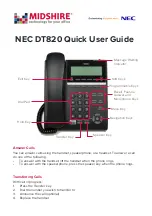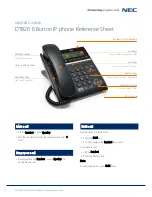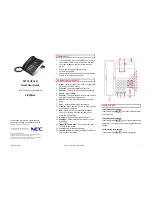
Consumer Update 81
&
Consumer Update
&
Consumer Update on Mobile Phones
(Published by U.S. Food and Drug Administration, Center for Devices and Radiological
Health, October 20, 1999.)
FDA has been receiving inquiries about the safety of mobile phones, including cellular
phones and PCS phones. The following summarizes what is known--and what remains
unknown--about whether these products can pose a hazard to health, and what can be done
to minimize any potential risk. This information may be used to respond to questions.
Why the concern?
Mobile phones emit low levels of radiofrequency energy (i.e., radiofrequency radiation) in
the microwave range while being used. They also emit very low levels of radiofrequency
energy (RF), considered non-significant, when in the stand-by mode. It is well known that
high levels of RF can produce biological damage through heating effects (this is how your
microwave oven is able to cook food). However, it is not known whether, to what extent, or
through what mechanism, lower levels of RF might cause adverse health effects as well.
Although some research has been done to address these questions, no clear picture of the
biological effects of this type of radiation has emerged to date. Thus, the available science
does not allow us to conclude that mobile phones are absolutely safe, or that they are
unsafe. However, the available scientific evidence does not demonstrate any adverse health
effects associated with the use of mobile phones.
What kind of phones are in question?
Questions have been raised about hand-held mobile phones, the kind that have a built-in
antenna that is positioned close to the user’s head during normal telephone conversation.
These types of mobile phones are of concern because of the short distance between the
phone’s antenna — the primary source of the RF — and the person’s head. The exposure to
RF from mobile phones in which the antenna is located at greater distances from the user
(on the outside of a car, for example) is drastically lower than that from hand-held phones,
because a person’s RF exposure decreases rapidly with distance from the source. The
safety of so-called “cordless phones", which have a base unit connected to the telephone
wiring in a house and which operate at far lower power levels and frequencies, has not been
questioned.
How much evidence is there that hand-held mobile phones might be harm-
ful?
Briefly, there is not enough evidence to know for sure, either way; however, research efforts
are on-going. The existing scientific evidence is conflicting and many of the studies that
have been done to date have suffered from flaws in their research methods. Animal
experiments investigating the effects of RF exposures characteristic of mobile phones have
yielded conflicting results. A few animal studies, however, have suggested that low levels of
RF could accelerate the development of cancer in laboratory animals. In one study, mice
genetically altered to be predisposed to developing one type of cancer developed more than
twice as many such cancers when they were exposed to RF energy compared to controls.
There is much uncertainty among scientists about whether results obtained from animal
studies apply to the use of mobile phones. First, it is uncertain how to apply the results
obtained in rats and mice to humans. Second, many of the studies that showed increased
tumor development used animals that had already been treated with cancer-causing
chemicals, and other studies exposed the animals to the RF virtually continuously — up to
22 hours per day.
For the past five years in the United States, the mobile phone industry has supported
research into the safety of mobile phones. This research has resulted in two findings in
particular that merit additional study:
Содержание Allure EB-TX310
Страница 2: ......
Страница 3: ......
Страница 42: ...Chapter 4 30 Text Entry Operations ...
Страница 50: ...Chapter 5 38 Phonebook Features ...
Страница 101: ......










































